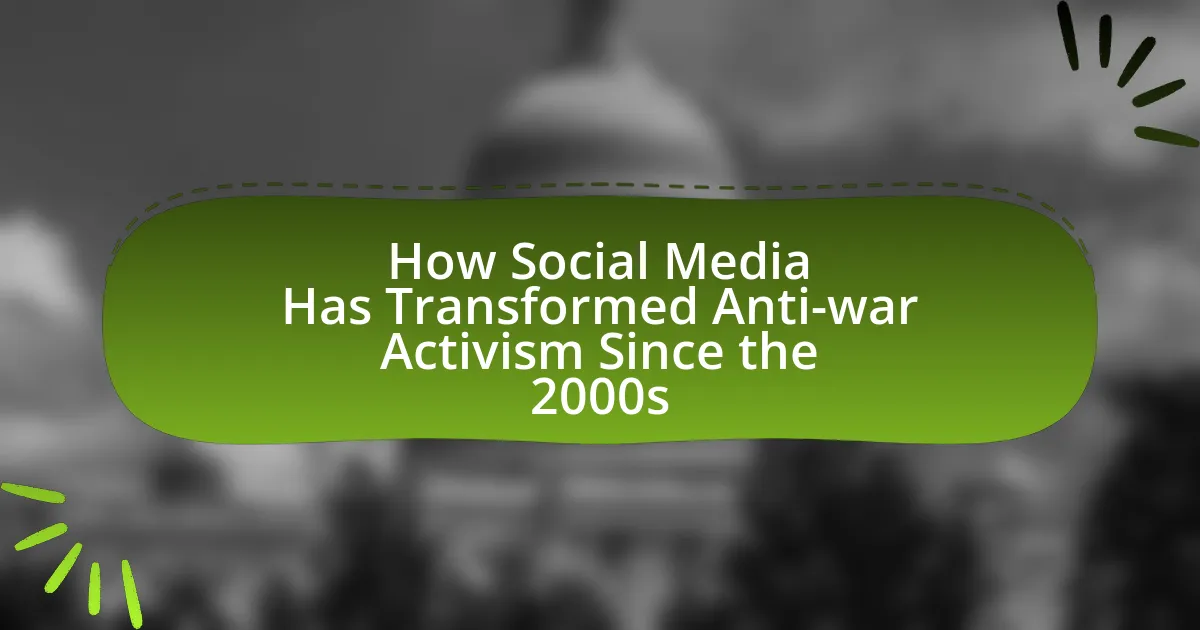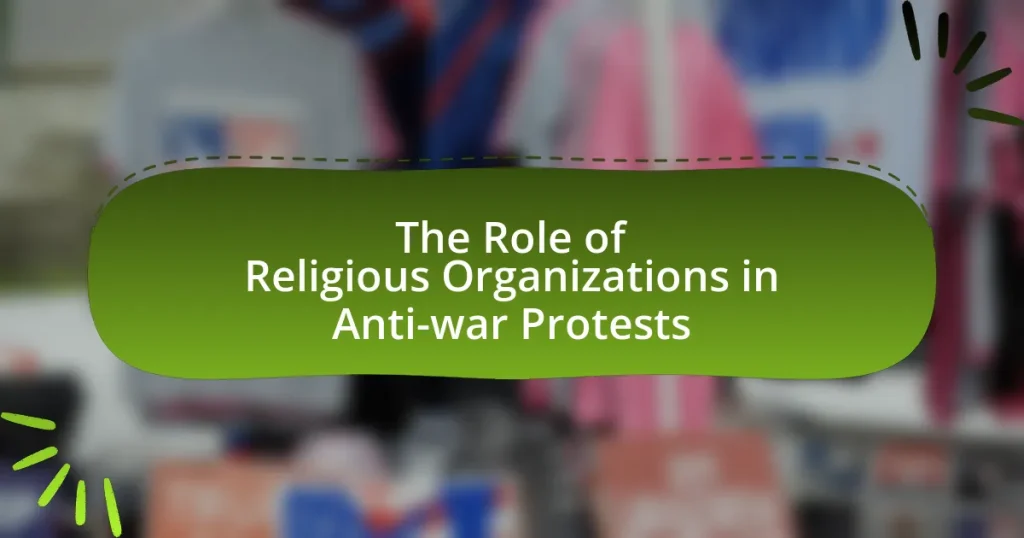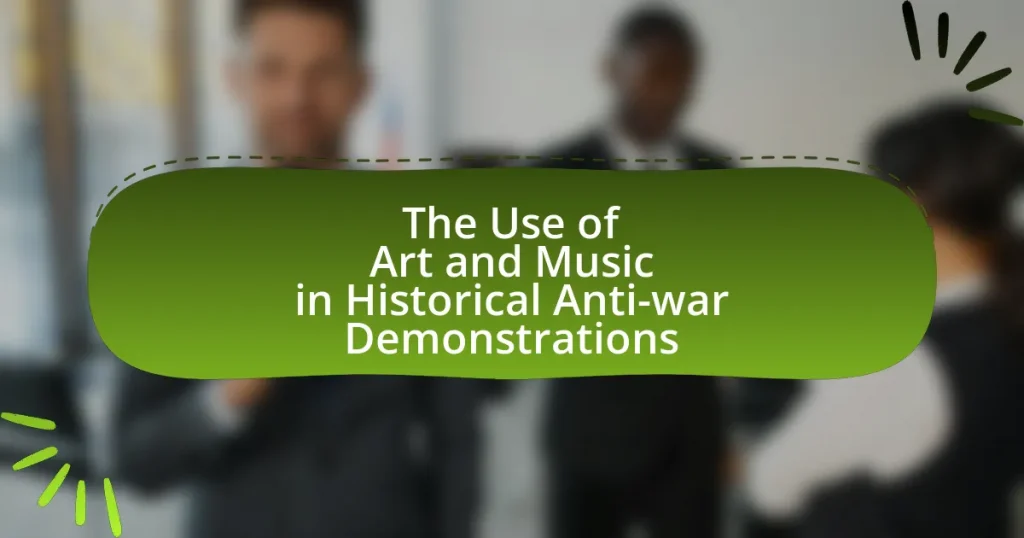The article examines how social media has transformed anti-war activism since the 2000s, highlighting its role in facilitating rapid information dissemination, global connectivity, and grassroots mobilization. It discusses the impact of platforms like Facebook and Twitter in organizing protests, amplifying marginalized voices, and shaping public opinion on military conflicts. Key features of social media that enhance activism, such as real-time updates and community building, are analyzed, along with the challenges activists face, including misinformation and censorship. The article also explores notable anti-war movements that emerged during this era and the strategies employed by different demographics to engage in activism online.
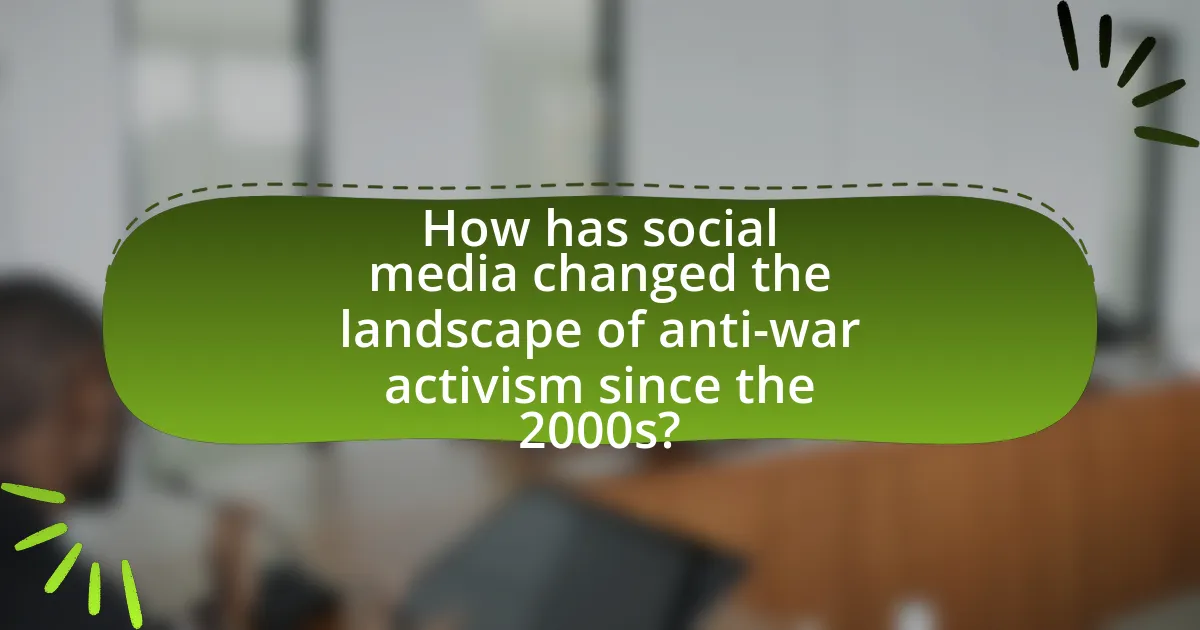
How has social media changed the landscape of anti-war activism since the 2000s?
Social media has significantly transformed anti-war activism since the 2000s by enabling rapid information dissemination and fostering global connectivity among activists. Platforms like Facebook, Twitter, and Instagram have allowed individuals and organizations to organize protests, share real-time updates, and mobilize support across borders, which was less feasible before the advent of these technologies. For instance, the 2003 Iraq War saw a surge in online campaigns, with millions participating in virtual protests and sharing anti-war messages, leading to a more informed and engaged public. Additionally, social media has provided a space for marginalized voices to be heard, amplifying grassroots movements and creating a more diverse anti-war narrative. The ability to reach a global audience instantly has made social media a powerful tool for shaping public opinion and influencing political discourse regarding military conflicts.
What role does social media play in mobilizing anti-war movements?
Social media plays a crucial role in mobilizing anti-war movements by facilitating rapid communication, organization, and dissemination of information among activists. Platforms like Twitter, Facebook, and Instagram enable individuals and groups to share their messages widely, coordinate protests, and engage with a global audience. For instance, during the 2003 Iraq War, social media was instrumental in organizing large-scale protests, with millions participating worldwide, demonstrating the power of online platforms to galvanize public sentiment against military actions. Additionally, studies have shown that social media campaigns can significantly increase awareness and participation in anti-war initiatives, as seen in the #NoWar movement, which utilized hashtags to unify voices and amplify calls for peace.
How do platforms like Twitter and Facebook facilitate organization and outreach?
Platforms like Twitter and Facebook facilitate organization and outreach by enabling rapid communication and mobilization among users. These social media platforms allow activists to share information, coordinate events, and engage with a broader audience instantly. For instance, Twitter’s character limit encourages concise messaging, making it easier to disseminate key points quickly, while Facebook’s event features allow users to create and promote gatherings, reaching thousands in a short time. Research indicates that during significant anti-war protests, such as the 2003 Iraq War demonstrations, social media played a crucial role in organizing participants, with Facebook groups and Twitter hashtags becoming central to mobilization efforts.
What are the key features of social media that enhance activism?
The key features of social media that enhance activism include rapid information dissemination, community building, and the ability to mobilize supporters. Rapid information dissemination allows activists to share news and updates instantly, reaching a global audience and raising awareness about issues quickly. Community building fosters connections among like-minded individuals, creating networks that support collective action and amplify voices. The ability to mobilize supporters enables organizations to coordinate events, protests, and campaigns effectively, as seen in movements like the Arab Spring, where social media played a crucial role in organizing demonstrations and spreading messages. These features collectively empower activists to engage larger audiences and drive social change.
Why is social media a powerful tool for anti-war activists?
Social media is a powerful tool for anti-war activists because it enables rapid dissemination of information and mobilization of support. Platforms like Twitter and Facebook allow activists to share real-time updates, organize protests, and connect with a global audience, amplifying their message beyond traditional media constraints. For instance, during the Iraq War, social media campaigns significantly increased public awareness and opposition, as seen in the 2003 protests where millions participated worldwide, largely coordinated through online platforms. This ability to reach and engage diverse populations enhances the effectiveness of anti-war movements, making social media an essential component of contemporary activism.
How does social media amplify voices that are often marginalized?
Social media amplifies voices that are often marginalized by providing a platform for direct communication and community building, enabling individuals to share their experiences and perspectives widely. This democratization of information allows marginalized groups, such as activists and minority communities, to bypass traditional media gatekeepers and reach larger audiences. For instance, the #BlackLivesMatter movement gained significant traction through social media, mobilizing support and raising awareness about systemic racism and police brutality. Research indicates that social media campaigns can lead to increased visibility and engagement, as seen in studies showing that online activism can translate into real-world protests and policy changes.
What impact does real-time information sharing have on public perception?
Real-time information sharing significantly influences public perception by enhancing transparency and immediacy in communication. This immediacy allows individuals to receive updates on events as they unfold, shaping their understanding and emotional responses. For instance, during the Iraq War, social media platforms enabled activists to disseminate information rapidly, countering mainstream narratives and mobilizing public opinion against the war. Research by the Pew Research Center indicates that 64% of Americans believe social media has a major impact on political and social issues, demonstrating its role in shaping perceptions.
What challenges do anti-war activists face on social media?
Anti-war activists face significant challenges on social media, including censorship, misinformation, and algorithmic bias. Censorship occurs when platforms remove or restrict content that opposes war narratives, limiting the visibility of anti-war messages. Misinformation spreads rapidly, often overshadowing factual anti-war content, making it difficult for activists to convey accurate information. Additionally, algorithmic bias can suppress anti-war posts in favor of pro-war content, reducing engagement and reach. These challenges hinder the effectiveness of anti-war activism online, as evidenced by numerous reports of content removal and the prevalence of false narratives dominating discussions on platforms like Facebook and Twitter.
How do misinformation and propaganda affect anti-war campaigns?
Misinformation and propaganda significantly undermine anti-war campaigns by distorting public perception and eroding trust in credible sources. For instance, during the Iraq War, false narratives about weapons of mass destruction fueled support for military action, diverting attention from anti-war messages. Research by the Pew Research Center indicates that misinformation spreads rapidly on social media, leading to confusion and polarization among the public. This environment makes it challenging for anti-war activists to convey accurate information and mobilize support, as competing narratives can overshadow their efforts.
What are the risks of surveillance and censorship for activists online?
The risks of surveillance and censorship for activists online include the potential for repression, loss of privacy, and diminished freedom of expression. Surveillance can lead to the identification and targeting of activists by authorities, which may result in harassment, arrest, or violence. For instance, the 2011 Arab Spring highlighted how governments used surveillance technologies to track and suppress dissent. Censorship can stifle the dissemination of critical information, limiting activists’ ability to organize and mobilize support. According to a report by Freedom House, in 2021, 73% of internet users lived in countries where criticism of the government was subject to censorship, illustrating the pervasive threat to online activism.
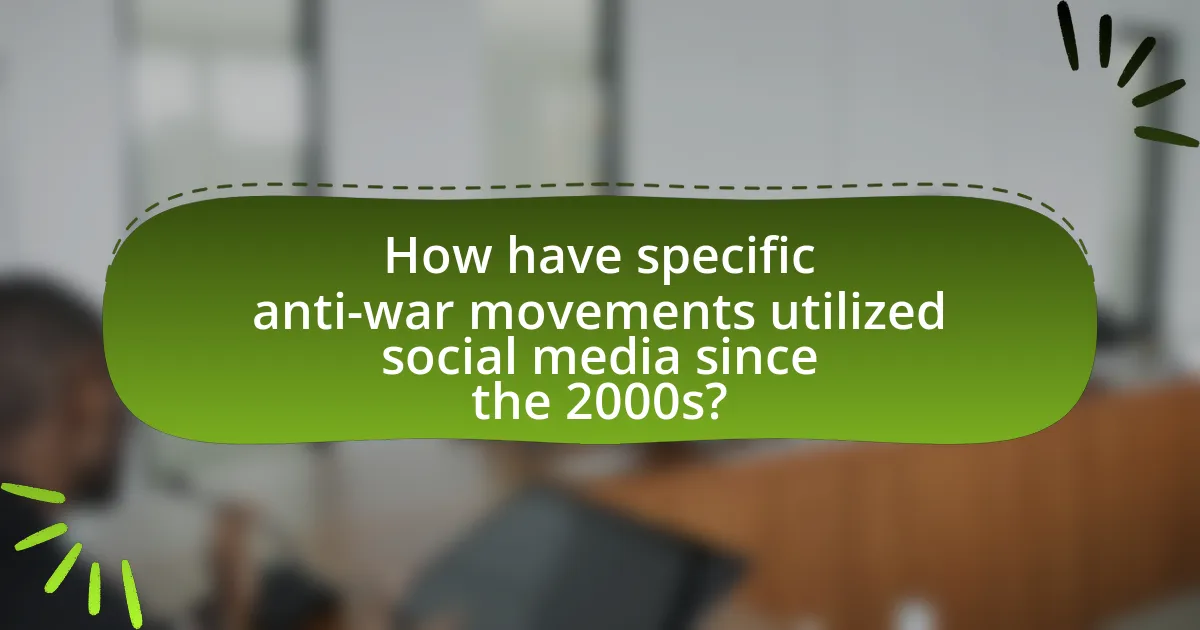
How have specific anti-war movements utilized social media since the 2000s?
Specific anti-war movements have utilized social media since the 2000s to mobilize supporters, disseminate information, and coordinate protests. For instance, the Iraq War protests in 2003 saw organizations like United for Peace and Justice leverage platforms such as Facebook and Twitter to organize large-scale demonstrations, reaching millions of users quickly. Additionally, the Arab Spring in 2011 exemplified how social media facilitated anti-war sentiments, with activists using Twitter to share real-time updates and rally support against oppressive regimes. Research indicates that social media has enabled grassroots movements to bypass traditional media, allowing for a more direct and immediate connection with the public, thus amplifying their messages and increasing participation in anti-war activities.
What are some notable anti-war movements that emerged in the social media era?
Notable anti-war movements that emerged in the social media era include the “Stop the War Coalition” in the UK, which gained traction through platforms like Facebook and Twitter during the Iraq War, and the “Occupy Wall Street” movement, which highlighted military spending as a key issue. The “No More War” campaign, which mobilized protests against U.S. military actions in Syria and Afghanistan, also utilized social media for organization and outreach. These movements leveraged social media to disseminate information rapidly, organize events, and engage a broader audience, demonstrating the significant impact of digital platforms on anti-war activism.
How did the Iraq War protests leverage social media for mobilization?
The Iraq War protests effectively leveraged social media for mobilization by utilizing platforms like Facebook, Twitter, and YouTube to organize events, disseminate information, and engage a broader audience. These platforms allowed activists to quickly share updates, coordinate protests, and amplify their messages, reaching millions of users globally. For instance, the “Not In Our Name” campaign used social media to mobilize thousands for protests in cities across the United States, demonstrating the power of online networks in rallying support. Additionally, the viral nature of social media enabled real-time sharing of images and videos from protests, which further galvanized public interest and participation, as evidenced by the large turnout at events like the February 15, 2003, global protests against the war, where millions participated worldwide.
What strategies did activists use during the Syrian Civil War to raise awareness?
Activists during the Syrian Civil War utilized social media platforms, citizen journalism, and grassroots organizing to raise awareness about the conflict. Social media, particularly Twitter and Facebook, allowed activists to share real-time updates, images, and videos of the violence, reaching a global audience and mobilizing international support. Citizen journalism emerged as a critical tool, with individuals documenting events on the ground, providing firsthand accounts that countered state narratives. Additionally, grassroots organizing facilitated local and international protests, amplifying calls for action and solidarity. These strategies collectively enhanced visibility and understanding of the humanitarian crisis, influencing public opinion and policy responses worldwide.
How do different demographics engage with social media for anti-war activism?
Different demographics engage with social media for anti-war activism through tailored content and platforms that resonate with their values and communication styles. For instance, younger individuals, particularly Millennials and Gen Z, predominantly utilize platforms like Instagram and TikTok to share visually compelling narratives and memes that highlight anti-war sentiments, often leading to viral campaigns. In contrast, older demographics, such as Baby Boomers, may prefer Facebook and Twitter for sharing articles, organizing events, and participating in discussions that emphasize historical context and policy critiques.
Research indicates that 70% of young activists believe social media is crucial for mobilizing support, while older generations often leverage these platforms for information dissemination and community building (Pew Research Center, 2021). This generational divide illustrates how different age groups adapt their engagement strategies based on their familiarity with technology and social media trends, ultimately shaping the landscape of anti-war activism.
What role do younger generations play in shaping anti-war narratives online?
Younger generations play a crucial role in shaping anti-war narratives online by utilizing social media platforms to disseminate information, mobilize support, and foster community engagement. Their adeptness with digital tools allows them to create and share content that challenges mainstream narratives, often highlighting the human cost of war and advocating for peace. For instance, movements like #NoWar and #PeaceNow have gained traction among younger users, who leverage hashtags to amplify their messages and connect with like-minded individuals globally. Research indicates that social media has become a primary source of news for younger demographics, influencing their perceptions and activism regarding war-related issues. This generational engagement not only reshapes public discourse but also pressures policymakers to consider the voices of younger constituents in discussions about military intervention and foreign policy.
How do cultural differences influence social media activism across countries?
Cultural differences significantly influence social media activism across countries by shaping the values, communication styles, and engagement strategies of activists. For instance, collectivist cultures, such as those in many Asian countries, often emphasize community and group solidarity, leading to collective action campaigns that utilize social media to mobilize large groups for protests or awareness initiatives. In contrast, individualistic cultures, like those in the United States, may focus on personal narratives and individual empowerment, resulting in campaigns that highlight personal stories and experiences to drive engagement.
Research indicates that cultural context affects the effectiveness of social media platforms in activism; for example, a study by the Pew Research Center found that social media usage patterns vary widely across cultures, influencing how messages are shared and received. Additionally, the language used in social media activism can reflect cultural norms, with some cultures favoring direct communication while others may prefer more nuanced or indirect approaches. These differences can determine the success of campaigns, as seen in the varying responses to movements like Black Lives Matter in the U.S. compared to similar movements in other countries, where local cultural factors shape the discourse and mobilization strategies.
What lessons can be learned from successful social media campaigns?
Successful social media campaigns demonstrate the importance of audience engagement and targeted messaging. Engaging content that resonates with the audience fosters community and encourages sharing, which amplifies reach. For instance, the Ice Bucket Challenge in 2014 raised over $115 million for ALS research by leveraging user-generated content and social sharing. Additionally, successful campaigns often utilize data analytics to refine strategies, ensuring that messages are tailored to specific demographics, as seen in the 2016 #BlackLivesMatter movement, which effectively mobilized support through targeted outreach and real-time engagement. These examples illustrate that understanding the audience and adapting strategies based on feedback are crucial for success in social media campaigns.
What tactics have proven effective in gaining traction for anti-war messages?
Effective tactics for gaining traction for anti-war messages include leveraging social media platforms, organizing grassroots campaigns, and utilizing visual storytelling. Social media platforms like Twitter and Facebook have enabled activists to reach a global audience quickly, facilitating the rapid dissemination of anti-war content. Grassroots campaigns, such as local protests and community events, create personal connections and mobilize individuals to participate actively. Visual storytelling, through videos and infographics, captures attention and conveys emotional narratives that resonate with audiences, making the anti-war message more impactful. These tactics have been validated by numerous successful movements, such as the global protests against the Iraq War in 2003, which utilized social media to organize and amplify their messages effectively.
How can activists measure the impact of their social media efforts?
Activists can measure the impact of their social media efforts through metrics such as engagement rates, reach, and conversion rates. Engagement rates, which include likes, shares, and comments, indicate how well the content resonates with the audience. Reach measures the number of unique users who see the content, providing insight into the campaign’s visibility. Conversion rates track specific actions taken by users, such as signing petitions or attending events, demonstrating the effectiveness of the social media strategy. According to a study by the Pew Research Center, 69% of adults in the U.S. use social media, highlighting its potential as a powerful tool for activism.
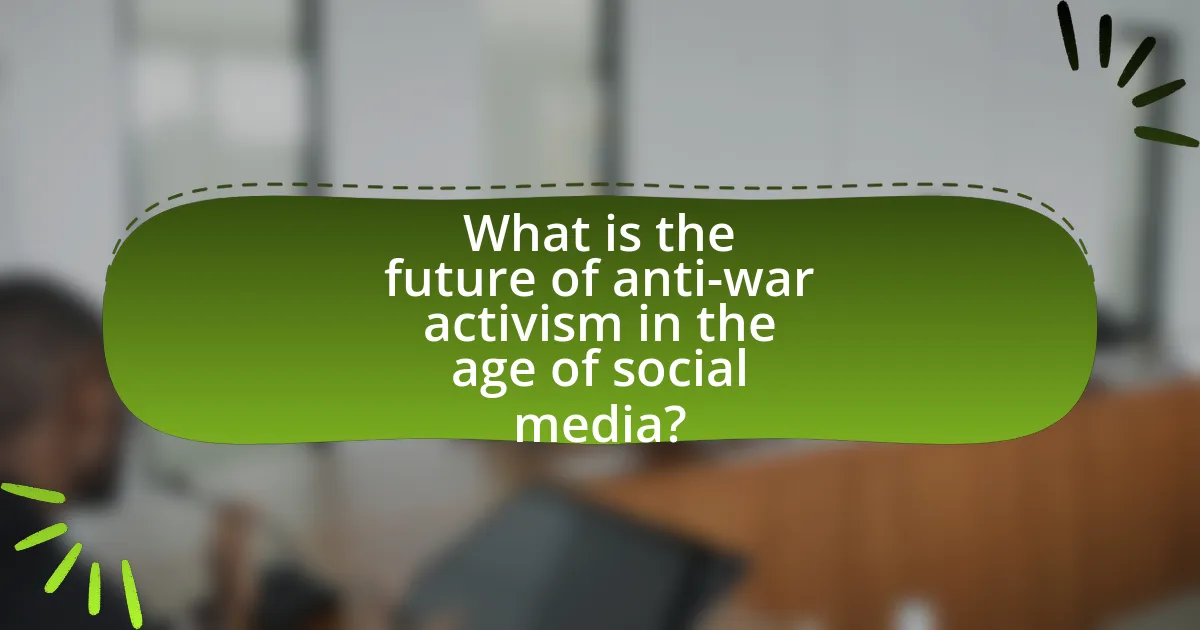
What is the future of anti-war activism in the age of social media?
The future of anti-war activism in the age of social media is likely to be characterized by increased visibility and mobilization, as platforms enable rapid dissemination of information and grassroots organizing. Social media has already demonstrated its power in movements like the Arab Spring, where activists utilized platforms to coordinate protests and share real-time updates, leading to significant political changes. Furthermore, studies indicate that social media campaigns can amplify voices that are often marginalized, allowing for a broader range of perspectives in anti-war discourse. As algorithms increasingly favor engaging content, anti-war activists may leverage this to reach wider audiences, potentially influencing public opinion and policy.
How might emerging technologies influence anti-war activism?
Emerging technologies significantly influence anti-war activism by enhancing communication, mobilization, and awareness. Social media platforms, for instance, allow activists to disseminate information rapidly, organize protests, and connect with a global audience, as seen during the Arab Spring in 2011, where platforms like Twitter and Facebook played crucial roles in mobilizing protests against authoritarian regimes. Additionally, advancements in digital tools, such as live-streaming and crowdfunding, empower activists to document events in real-time and secure financial support for their initiatives. These technologies facilitate grassroots movements, enabling a more decentralized and inclusive approach to activism, which has been evidenced by the widespread participation in movements like Black Lives Matter, where anti-war sentiments often intersect with broader social justice issues.
What potential does artificial intelligence hold for activism strategies?
Artificial intelligence holds significant potential for activism strategies by enhancing data analysis, improving outreach, and facilitating targeted messaging. AI can analyze vast amounts of social media data to identify trends, sentiments, and key influencers, enabling activists to tailor their campaigns effectively. For instance, AI-driven tools can predict public reactions to specific issues, allowing organizations to adjust their strategies in real-time. Additionally, AI can automate content creation and distribution, ensuring that messages reach the right audiences at optimal times. Research from the Pew Research Center indicates that 69% of Americans believe social media is an effective tool for activism, highlighting the importance of integrating AI to maximize impact in digital spaces.
How could virtual reality change the way activists share their messages?
Virtual reality could revolutionize how activists share their messages by creating immersive experiences that engage audiences on a deeper emotional level. This technology allows activists to simulate real-world scenarios, enabling viewers to experience the impact of war and conflict firsthand. For instance, studies have shown that virtual reality can increase empathy and understanding, as evidenced by projects like “The Enemy,” which immerses users in the perspective of individuals affected by war. By utilizing virtual reality, activists can convey complex narratives and foster a stronger connection with their audience, ultimately enhancing the effectiveness of their campaigns.
What best practices should activists adopt for effective social media engagement?
Activists should adopt a strategy of consistent messaging, audience engagement, and data-driven content for effective social media engagement. Consistent messaging ensures that the core values and objectives of the activism are clearly communicated, which helps in building a recognizable brand and fostering trust among followers. Engaging with the audience through comments, shares, and direct messages creates a sense of community and encourages participation, which is crucial for mobilizing support. Utilizing data-driven content, such as analytics to understand audience preferences and behaviors, allows activists to tailor their posts for maximum impact, increasing the likelihood of reaching a broader audience. According to a study by the Pew Research Center, 69% of adults in the U.S. use social media, highlighting the platform’s potential for outreach and engagement in activism.
How can activists build and maintain online communities for sustained impact?
Activists can build and maintain online communities for sustained impact by leveraging social media platforms to create engaging content, foster dialogue, and establish a sense of belonging among members. By utilizing tools such as Facebook groups, Twitter hashtags, and Instagram stories, activists can effectively disseminate information, mobilize supporters, and encourage participation in campaigns. Research indicates that online communities can enhance engagement; for instance, a study by Pew Research Center found that 69% of adults in the U.S. use social media, making it a powerful tool for outreach and connection. Additionally, consistent communication and active moderation help maintain community cohesion and encourage ongoing participation, which is crucial for long-term impact.
What strategies can be employed to counteract misinformation in activism?
To counteract misinformation in activism, organizations can employ fact-checking, media literacy education, and strategic communication. Fact-checking involves verifying claims before dissemination, which can reduce the spread of false information. Media literacy education equips activists and the public with skills to critically evaluate sources and discern credible information from misinformation. Strategic communication includes crafting clear, consistent messages that address common misconceptions directly, thereby reinforcing accurate narratives. Research indicates that misinformation can significantly undermine public trust and engagement; therefore, these strategies are essential for maintaining the integrity of activist movements.
What are the key takeaways for future anti-war activists using social media?
Future anti-war activists should prioritize building strong online communities and utilizing diverse social media platforms to amplify their messages. Engaging with followers through interactive content, such as live discussions and polls, fosters a sense of belonging and encourages participation. Additionally, leveraging data analytics can help activists understand audience demographics and tailor their campaigns effectively. Historical examples, such as the Arab Spring in 2011, demonstrate how social media mobilized large groups for anti-war protests, highlighting its potential to create significant social change.
